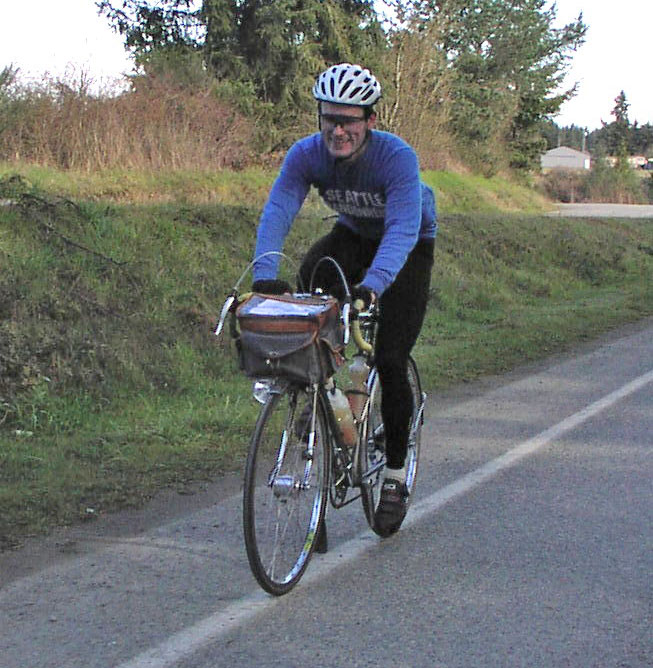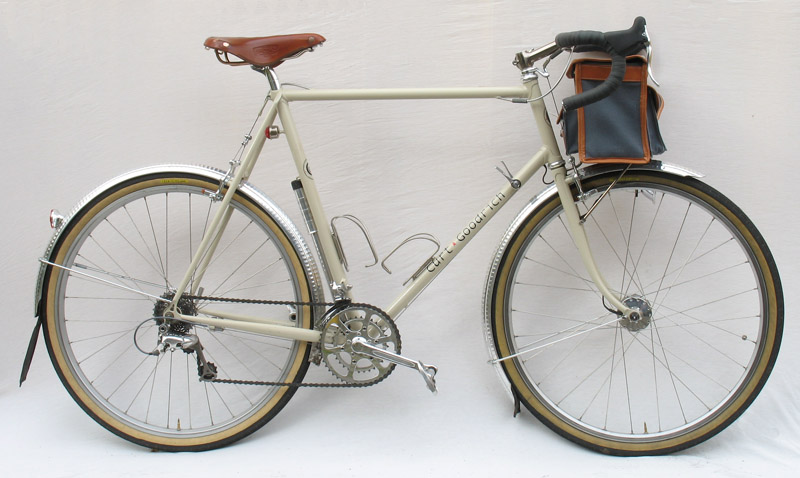A Journey of Discovery, Part 4: Front-End Geometry

How did our preferences change from our familiar bikes with mid-trail geometries, 700C x 28 mm tires and saddlebags to low-trail 650B bikes with much wider tires and handlebar bags? In the previous parts of this series, we related how we found out about the advantages of handlebar bags, aluminum fenders, and supple, wide tires.
Then we discovered how much difference front-end geometries can make. Both Mark and I had ridden tens of thousands of miles on bikes with “mid-trail” geometries – about 55 mm trail with 700C x 28 mm tires. In 1999, we each had custom bikes made with that geometry, because at the time, we felt that they offered the best handling we had experienced on a bike. When an American bicycle maker asked Bicycle Quarterly about ideas for the perfect randonneur bike, I talked at length about lights and racks. When the maker asked about geometry, I replied: “Your slightly relaxed geometry probably is just about perfect for a randonneur bike.”
Then I started riding an old Alex Singer randonneur bike (see above) once in a while. The Singer surprised me: “Tricky” corners suddenly were less difficult. When I noticed a pothole too late, and thought that I would not be able to steer around it, I braced myself for the impact. To my surprise, the bike responded quickly enough to avoid the pothole. When I got tired, the Singer was easier to keep on a straight line – in fact, I could ride on the white painted “fog line” for miles with little concentration (see photo at the top of the post). Riding no-hands at moderate speeds was easier, too. This confused me: The Singer had “quicker,” more precise steering, yet it was more stable.
When I switched back to my normal bike after a single ride on the Singer, I found myself running wide in corners. I hit potholes that I thought I would miss. And the bike sometimes weaved unexpectedly when I was getting tired. Both bikes had a similar riding positions, both had handlebar bags, but something was different. To my surprise, the bike I rode all the time felt less intuitive than the new-to-me Singer.
That is when we started measuring geometries. We realized that the Singer’s geometry was anything but the “relaxed” geometry we had expected. The bike had a steep head angle and less trail than was common at the time.
During Mark’s first ride on my Singer, over a challenging stretch of road, he exclaimed: “Now I know how a bike should handle.” We both immediately preferred the “optimized” bike over the ones we usually rode.
This raises an interesting question: Is habituation stronger than optimization? Will a rider just prefer the bike they usually ride, or is there an “optimum” setup that will appear superior even to those who are not used to riding it? Based on our experiences with front-end geometry, we prefer “optimimized” bikes over those we usually ride.
I began riding the old Singer more and more, until it had replaced my usual bike. And Mark ordered a new custom bike altogether.

Mark’s new bike was designed around the Mitsuboshi 650B x 38 mm tires that I had used in the 2003 Paris-Brest-Paris. It used the geometry of the 1952 René Herse that I had liked so much. Of course, Mark’s new bike was equipped with a handlebar bag and aluminum fenders. And by now, we also had discovered that we did not need very large gears. The “compact doubles” used on many classic randonneur bikes allowed us to ride most terrain in the big chainring, thus eliminating many front shifts.
Mark initially intended his new bike as a special bike for fast events. He planned to use his old bike on gravel roads, for touring and many other rides. In the end, he preferred his new bike so much that he rode it all the time. He even made a low-rider rack for it, so he could take it touring.
So by 2005, our “best bikes in the world” had been replaced by a 1973 French Alex Singer and by a modern bike inspired by a 1952 René Herse. But our journey of discovery was not yet over…
Click here to go to Part 5 of this series.
Click here to start reading with Part 1 of this series.
Further reading:
– Front-End Geometry for Different Loads, Speeds and Tire Sizes. Bicycle Quarterly Vol. 3, No. 3.
– What Makes a Well-Handling Bike” with sample geometries for all applications. Bicycle Quarterly Vol. 5, No. 3.


